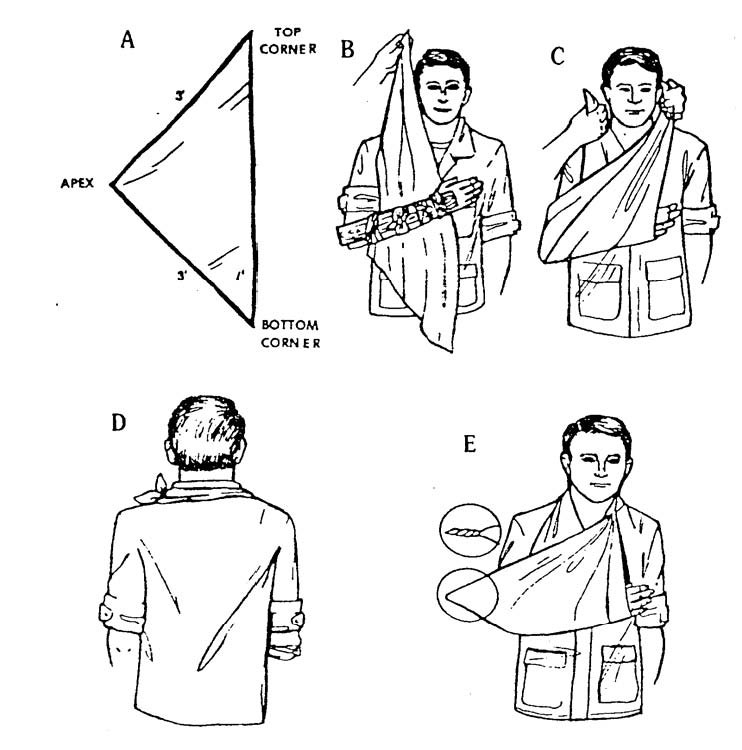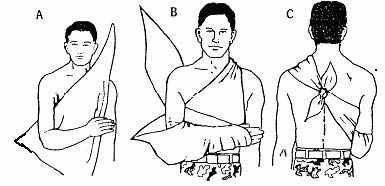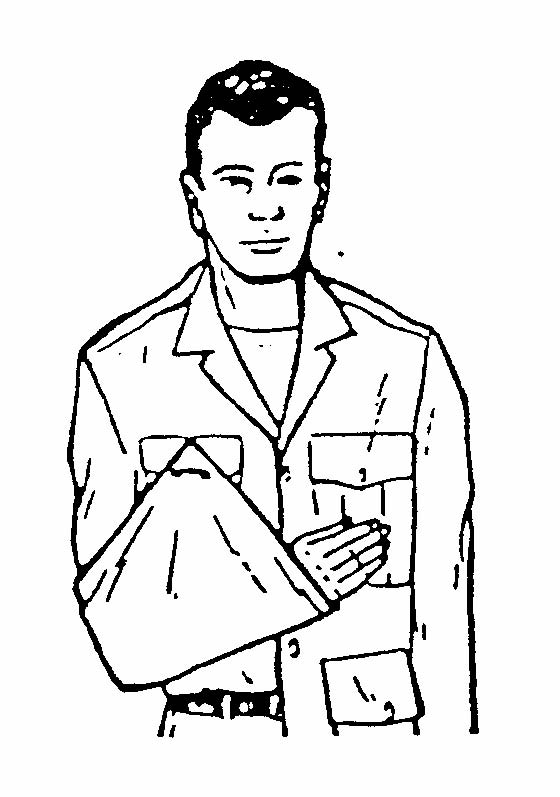Treating Fractures in the Field
Lesson 5: Fractures of the Upper Extremities
5-8
5-8. APPLY A SLING TO AN ARM
A sling is used to support and immobilize the forearm. It also serves to immobilize the elbow and upper arm. A sling is normally made from a triangular bandage (see paragraph 2-4c and figure 5-8 A). A swathe is normally applied to further immobilize the casualty's injured arm.
NOTE: The shoulder, upper arm, elbow, and forearm on the injured side may be
referred to as "injured" whether or not that particular body part is actually
injured.
a. Apply a Sling (Arm Sling Number One) to an Arm. This arm sling is used when the shoulder of the injured arm is not injured.
(1) Insert the triangular bandage between the injured arm and the casualty's chest so the arm is in the center, the apex of the sling is beyond the elbow, and the top corner of the material is over the shoulder of the injured side (see figure 5-8 B).
Figure 5-8. Applying a triangular bandage sling (arm sling number one).
(2) Position the forearm so the hand is slightly higher than the elbow (about a 10 degree angle).
(3) Fold the material along the base (the long side opposite the apex) back to the casualty's fingers, forming a cuff.
(4) Bring the lower portion of the material over the injured arm so the bottom corner goes over the shoulder of the uninjured side (see figure 5-8 C). The elbow should be inside the sling.
(5) Bring the top corner behind the casualty's neck.
(6) Tie the two corners together in a non-slip knot at the "hollow" at the neck on the uninjured side (see figure 5-8 D). If the casualty's right arm is fractured, for example, tie the knot so it will rest in the hollow on the left side of his neck.
(7) Secure the apex of the sling to keep the elbow and forearm from slipping out of the sling.
(a) Safety pin method. Fold the apex forward over the elbow and sling. Pin the apex to the sling.
(b) Pig tailing (twisting) method. Twist the apex of the sling and tuck it in at the elbow (see figure 5-8 E).
b. Apply a Sling (Arm Sling Number Two) to an Arm. This arm sling is used when the shoulder of the injured arm is also injured (dislocated or fractured). Note that the sling goes under, not over, the injured shoulder.
(1) Insert the triangular bandage between the injured arm and the casualty's chest so the arm is in the center, the apex of the sling is beyond the elbow, and the top corner of the material is
over the shoulder of the uninjured side (see figure 5-9 A).
(2) Position the forearm so the hand is slightly higher than the elbow (about a 10-degree angle).
(3) Fold the material along the base (the long side opposite the apex) back to the casualty's fingers, forming a cuff.
(4) Bring the lower portion of the material over the injured forearm and under the armpit of the injured arm (see figure 5-9 B). The elbow should be inside the sling.
(5) Bring the top corner behind the casualty's neck.
(6) Tie the two corners together in a non-slip knot on the casualty's back between his shoulder blades (see figure 5-9 C).
Figure 5-9. Applying a triangular bandage sling (arm sling number two).
(7) Twist the apex of the sling and tuck it in at the elbow. The corner can also be secured using a safety pin or similar device.
c. Apply a Jacket Flap Sling to an Arm. The flap of a BDU jacket (coat) or a field jacket (coat) can be used as a sling if the time or the materials to make a triangular bandage sling are not available (see figure 5-10).
Figure 5-10. Jacket flap sling.
(1) Position the forearm on the casualty's chest with the hand positioned slightly higher than the elbow.
(2) Undo the jacket so the lower portion (flap) can be brought over the forearm to form a sling.
(3) Bring the flap up over the forearm to the pocket area. Position the elbow so that it is inside the sling and will not slip out of the sling.
(4) Push a stick or other rigid object through the flap and the upper portion of the jacket so the flap will not slip.




